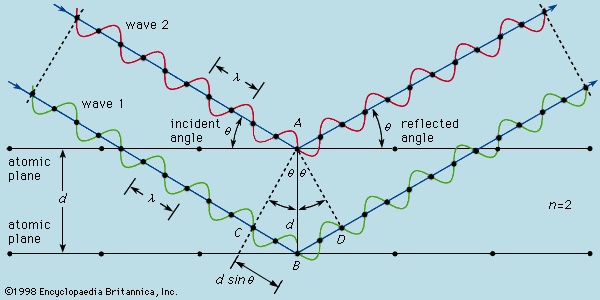Bragg law
crystals
in physics, the relation between the spacing of atomic planes in crystals and the angles of incidence at which these planes produce the most intense reflections of electromagnetic radiations, such as X rays (X-ray) and gamma rays, and particle waves, such as those associated with electrons and neutrons. For maximum intensity of reflected wave trains, they must stay in phase to produce constructive interference, in which corresponding points of a wave (e.g., its crests or troughs) arrive at a point simultaneously. The Bragg law was first formulated by Lawrence Bragg (Bragg, Sir Lawrence), an English physicist.
 The diagram shows waves 1 and 2, in phase with each other, glancing off atoms A and B of a crystal that has a separation distance d between its atomic, or lattice, planes. The reflected (glancing) angle θ, as shown by experiment, is equal to the incident angle θ. The condition for the two waves to stay in phase after both are reflected is that the path length CBD be a whole number (n) of wavelengths (λ), or nλ. But, from geometry, CB and BD are equal to each other and to the distance d times the sine of the reflected angle θ, or d sin θ. Thus, nλ = 2d sin θ, which is the Bragg law. As may be seen from the diagram, when n = 2 there is only one wavelength along path CB; also, the reflected angle will be smaller than that for, say, n = 3. Waves reflected through an angle corresponding to n = 1 are said to be in the first order of reflection; the angle corresponding to n = 2 is the second order, and so on. For any other angle (corresponding to fractional n) the reflected waves will be out of phase and destructive interference will occur, annihilating them.
The diagram shows waves 1 and 2, in phase with each other, glancing off atoms A and B of a crystal that has a separation distance d between its atomic, or lattice, planes. The reflected (glancing) angle θ, as shown by experiment, is equal to the incident angle θ. The condition for the two waves to stay in phase after both are reflected is that the path length CBD be a whole number (n) of wavelengths (λ), or nλ. But, from geometry, CB and BD are equal to each other and to the distance d times the sine of the reflected angle θ, or d sin θ. Thus, nλ = 2d sin θ, which is the Bragg law. As may be seen from the diagram, when n = 2 there is only one wavelength along path CB; also, the reflected angle will be smaller than that for, say, n = 3. Waves reflected through an angle corresponding to n = 1 are said to be in the first order of reflection; the angle corresponding to n = 2 is the second order, and so on. For any other angle (corresponding to fractional n) the reflected waves will be out of phase and destructive interference will occur, annihilating them.The Bragg law is useful for measuring wavelengths (wavelength) and for determining the lattice spacings of crystals. To measure a particular wavelength, the radiation beam and the detector are both set at some arbitrary angle θ. The angle is then modified until a strong signal is received. The Bragg angle, as it is called, then gives the wavelength directly from the Bragg law. This is the principal way to make precise energy measurements of X rays and low-energy gamma rays. The energies of neutrons, which by quantum theory have wave attributes, are frequently determined by Bragg reflection.
- Emmanuel-Joseph Sieyès
- Emmanuel Las Cases, Count (comte) de
- Emmanuel Lévinas
- Emmanuel Philibert
- Emmanuel Roblès
- Emma Southworth
- Emma Thompson
- Emma Willard
- Emma-ō
- Emmeline Blanche Woodward Wells
- Emmeline Pankhurst
- Emmen
- Emmentaler
- Emmerich de Vattel
- Emmerich Joseph von Dalberg Dalberg, duc de
- Emmerich Joseph von Dalberg, duc de Dalberg
- Emmerich Kálmán
- Emmerick, Blessed Anna Katharina
- Emmet, Robert
- Emmett, Daniel Decatur
- Emmet, Thomas Addis
- Emmett Kelly
- Emmett Till
- Emmitsburg
- Emmitt Smith